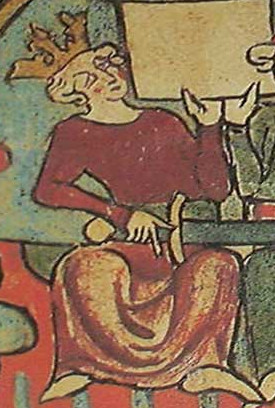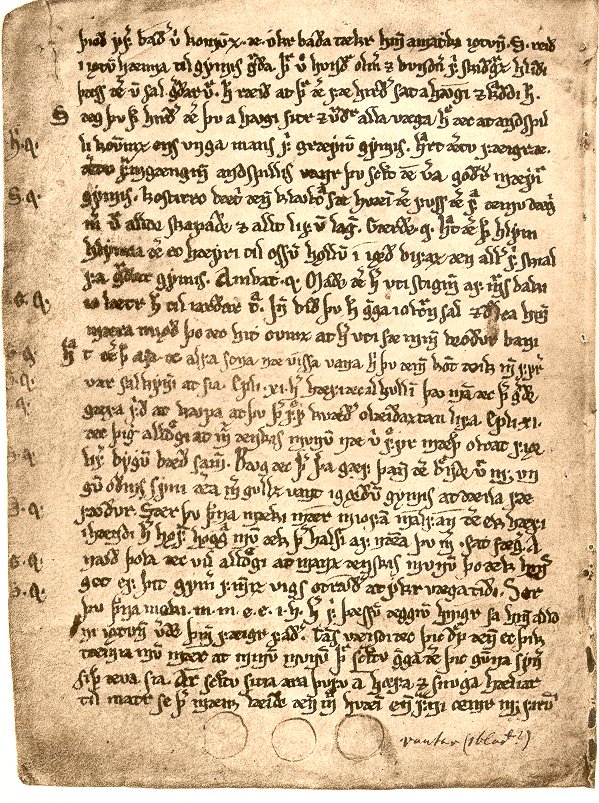|
Saulus Saga Ok Nikanors
''Saulus saga ok Nikanors'' (also known as ''Sálus saga og Nikanors'') is a medieval Icelandic romance saga. Its style is said to combine that of a romance as well as that of Sagas of Icelanders. Thematically, the saga discusses issues of power, embodied by Nikanor's sister's name, Potentiana. Synopsis Kalinke and Mitchell summarise the saga thus: Composed in Iceland, presumably in the fourteenth century. After a duel nearly to the death as a result of a chess game at the court of the Roman emperor, Prince Sálus of Galicia and Duke Nikanor of Bár become blood brothers and are involved in a series of tremendous battles in order to obtain Potentiana, Nikanor's sister, as Sálus' bride. Nikanor ultimately marries Luneta, daughter of King Benjamin of Akaia in Grikkland. There are many classical and Biblical elements and allusions. Manuscripts Kalinke and Mitchell identified the following manuscripts of the saga: Derived ''rímur'' Finnur Sigmundsson's catalogue of ''rí ... [...More Info...] [...Related Items...] OR: [Wikipedia] [Google] [Baidu] |
Romance Saga
The ''riddarasögur'' (literally 'sagas of knights', also known in English as 'chivalric sagas', 'romance-sagas', 'knights' sagas', 'sagas of chivalry') are Norse prose sagas of the romance genre. Starting in the thirteenth century with Norse translations of French '' chansons de geste'' and Latin romances and histories, the genre expanded in Iceland to indigenous creations in a similar style. While the ''riddarasögur'' were widely read in Iceland for many centuries they have traditionally been regarded as popular literature inferior in artistic quality to the Icelanders' sagas and other indigenous genres. Receiving little attention from scholars of Old Norse literature, many remain untranslated. The production of chivalric sagas in Scandinavia was focused on Norway in the thirteenth century and then Iceland in the fourteenth. Vernacular Danish and Swedish romances came to prominence rather later and were generally in verse; the most famous of these are the Eufemiavisorna, the ... [...More Info...] [...Related Items...] OR: [Wikipedia] [Google] [Baidu] |
Sagas Of Icelanders
The sagas of Icelanders ( is, Íslendingasögur, ), also known as family sagas, are one genre of Icelandic sagas. They are prose narratives mostly based on historical events that mostly took place in Iceland in the ninth, tenth, and early eleventh centuries, during the so-called Saga Age. They were written in Old Icelandic, a western dialect of Old Norse. They are the best-known specimens of Icelandic literature. They are focused on history, especially genealogical and family history. They reflect the struggle and conflict that arose within the societies of the early generations of Icelandic settlers. The Icelandic sagas are valuable and unique historical sources about medieval Scandinavian societies and kingdoms, in particular in regards to pre-Christian religion and culture. Eventually many of these Icelandic sagas were recorded, mostly in the 13th and 14th centuries. The 'authors', or rather recorders of these sagas are largely unknown. One saga, ''Egil's Saga'', is beli ... [...More Info...] [...Related Items...] OR: [Wikipedia] [Google] [Baidu] |
Rímur
In Icelandic literature, a ''ríma'' (, literally "a rhyme", pl. ''rímur'', ) is an epic poem written in any of the so-called ''rímnahættir'' (, "rímur meters"). They are rhymed, they alliterate and consist of two to four lines per stanza. The plural, ''rímur'', is either used as an ordinary plural, denoting any two or more rímur, but is also used for more expansive works, containing more than one ríma as a whole. Thus '' Ólafs ríma Haraldssonar'' denotes an epic about Ólafr Haraldsson in one ríma, while '' Núma rímur'' are a multi-part epic on Numa Pompilius. Form ''Rímur'', as the name suggests, rhyme, but like older Germanic alliterative verse, they also contain structural alliteration. ''Rímur'' are stanzaic, and stanzas normally have four lines. There are hundreds of ''ríma'' meters: Sveinbjörn Beinteinsson counts 450 variations in his ''Háttatal''. But they can be grouped in approximately ten ''families''. The most common metre is ''ferskeytt''.Véstein ... [...More Info...] [...Related Items...] OR: [Wikipedia] [Google] [Baidu] |
Finnur Jónsson
Finnur Jónsson (May 29, 1858 – March 30, 1934) was an Icelandic-Danish philologist and Professor of Nordic Philology at the University of Copenhagen. He made extensive contributions to the study of Old Norse literature. Finnur Jónsson was born at Akureyri in northern Iceland. He graduated from Menntaskólinn í Reykjavík in 1878 and went to Denmark for further studies at the University of Copenhagen. He received a doctorate in philology in 1884 with a dissertation on skaldic poetry. He became a docent at the university in 1887 and a professor in 1898, serving until 1928. After retiring he continued work on his subject with new publications until the year he died. He was elected member of the Royal Society of Arts and Sciences in Gothenburg in 1905 and corresponding member of the Royal Swedish Academy of Letters, History and Antiquities in 1908. Finnur's principal area of study was Old Norse poetry. His three most important works are ''Den norsk-islandske skjaldedigtning' ... [...More Info...] [...Related Items...] OR: [Wikipedia] [Google] [Baidu] |
Ægir
Ægir (anglicised as Aegir; Old Norse 'sea'), Hlér (Old Norse 'sea'), or Gymir (Old Norse less clearly 'sea, engulfer'), is a jötunn and a personification of the sea in Norse mythology. In the Old Norse record, Ægir hosts the gods in his halls and is associated with brewing ale. Ægir is attested as married to a goddess, Rán, who also personifies the sea, and together the two produced daughters who personify waves, the Nine Daughters of Ægir and Rán, and Ægir's son is Snær, personified snow. Ægir may also be the father of the beautiful jötunn Gerðr, wife of the god Freyr, or these may be two separate figures who share the same name (see below and Gymir (father of Gerðr)). One of Ægir's names, ''Hlér'', is the namesake of the island Læsø (Old Norse ''Hléysey'' 'Hlér's island') and perhaps also Lejre in Denmark. Scholars have long analyzed Ægir's role in the Old Norse corpus, and the concept of the figure has had some influence in modern popular culture. Names ... [...More Info...] [...Related Items...] OR: [Wikipedia] [Google] [Baidu] |
Rán
In Norse mythology, Rán (Old Norse: ) is a goddess and a personification of the sea. Rán and her husband Ægir, a jötunn who also personifies the sea, have nine daughters, who personify waves. The goddess is frequently associated with a net, which she uses to capture sea-goers. According to the prose introduction to a poem in the ''Poetic Edda'' and in ''Völsunga saga'', Rán once loaned her net to the god Loki. Rán is attested in the ''Poetic Edda'', compiled during the 13th century from earlier traditional sources; the ''Prose Edda'', written during the 13th century by Snorri Sturluson; in both ''Völsunga saga'' and '' Friðþjófs saga hins frœkna''; and in the poetry of skalds, such as ''Sonatorrek'', a 10th-century poem by Icelandic skald Egill Skallagrímsson. Etymology The Old Norse common noun ''rán'' means 'plundering' or 'theft, robbery'.Faulkes (1998: 250) and discussion in Simek (2007 993 260). In turn, scholars view the theonym ''Rán'' as meaning, for examp ... [...More Info...] [...Related Items...] OR: [Wikipedia] [Google] [Baidu] |
Chivalric Sagas
The ''riddarasögur'' (literally 'sagas of knights', also known in English as 'chivalric sagas', 'romance-sagas', 'knights' sagas', 'sagas of chivalry') are Norse prose sagas of the romance genre. Starting in the thirteenth century with Norse translations of French '' chansons de geste'' and Latin romances and histories, the genre expanded in Iceland to indigenous creations in a similar style. While the ''riddarasögur'' were widely read in Iceland for many centuries they have traditionally been regarded as popular literature inferior in artistic quality to the Icelanders' sagas and other indigenous genres. Receiving little attention from scholars of Old Norse literature, many remain untranslated. The production of chivalric sagas in Scandinavia was focused on Norway in the thirteenth century and then Iceland in the fourteenth. Vernacular Danish and Swedish romances came to prominence rather later and were generally in verse; the most famous of these are the Eufemiavisorna, them ... [...More Info...] [...Related Items...] OR: [Wikipedia] [Google] [Baidu] |
Icelandic Literature
Icelandic literature refers to literature written in Iceland or by Icelandic people. It is best known for the sagas written in medieval times, starting in the 13th century. As Icelandic and Old Norse are almost the same, and because Icelandic works constitute most of Old Norse literature, Old Norse literature is often wrongly considered a subset of Icelandic literature. However, works by Norwegians are present in the standard reader ''Sýnisbók íslenzkra bókmennta til miðrar átjándu aldar'', compiled by Sigurður Nordal on the grounds that the language was the same. Early Icelandic literature The medieval Icelandic literature is usually divided into three parts: *Eddic poetry *Sagas *Skaldic poetry The ''Eddas'' There has been some discussion on the probable etymology of the term "Edda". Most say it stems from the Old Norse term ''edda'', which means great-grandmother, but some see a reference to Oddi, a place where Snorri Sturluson Snorri Sturluson ( ; ; 1179 – 22 S ... [...More Info...] [...Related Items...] OR: [Wikipedia] [Google] [Baidu] |




